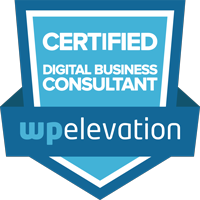
Jen Miller explains the importance of using Yoast SEO as a guide rather than a content dictator. Blogging allows freedom of expression and the words used need to fit your audience. Readability scores, while valuable in many industries, have less value when your readers expect the use of industry terms and advanced verbiage.
Hello, I’m Jen Miller and you are listening to another episode of Be Seen Blogging, the podcast that shares tips and tricks of how to create winning website content, all in under 10 minutes. On today’s show, #17, we’ll be discussing one of my favorite plugins, Yoast SEO. I began using Yoast SEO while it was in beta. While I agree it earns the title of “Definitive Guide” on website SEO, I also understand that the term guide is not law…. and you should too!
You see the plugin is useful because it reminds bloggers, new and seasoned, of the important elements to include in each post. From title and chosen keyword placement, to permalink, text length and meta description, using Yoast SEO results in more powerful blog posts. These suggestions increase performance. Readership grows as your post reaches more readers. Users refrain from using stop words. The plugin encourages that posts be written for a common audience, generally accepted as a 4th-5th grade reading level. And, it absolutely works.
If however you are in a technical or medical industry or happen to be a lawyer or astrophysicist, the Yoast SEO plugin may give you trouble. It encourages the use of familiar phrases and words, steering the writer from using too advanced of a tone. In some professions this can be rather limiting. In fact, business bloggers may find this to be the case often as case studies make reference to less common words and industry terms. This explains why Yoast SEO is used as a guide, not law.
The Yoast SEO plugin provides two indicators on post quality – the SEO factor and the readability factor.
Give your blog post the highest chance of success. Follow all SEO dictates outlined by the plugin (unless you are an advanced user with a specific purpose in mind). Use the recommendations I’ve outlined in past Need Someone To Blog posts, such as Go GREEN with Intentional Blogging to turn the Yoast SEO light from red to green.
Readability, however, is completely dependent on your audience. Review the suggestions given by the plugin and make an educated decision as to whether or not they apply to your post. In most cases, energizing a passive voice phrase makes sense. In some cases, such as an interview situation, it does not. Removing industry terms or “dumbing down” a post for academics would be a travesty. Yet, shortening a sentence to give it more punch is an excellent suggestion.
I’m a believer in using what works for you.
Follow every SEO recommendation and judge the readability after evaluating your goals for the blog post. Does your mandatory keyword phrase include a stop word? Use it. If you can only describe your product with industry jargon, then do so… but consider that you may need to break down the words to a level your customer’s understand. Should you find that longer sentence convey the feeling you want for a post, don’t shorten them and change meaning due to a low readability score.
Your website and your blog posts need to be in your recognizable voice, even if that means it may not be 100% correct in form.
Trust the plugin, but trust yourself more.
Thanks for listening to Be Seen Blogging! I hope you’ve enjoyed exploring the Yoast SEO plugin with me – it really is my favorite WordPress toy. Talk to you next week!












